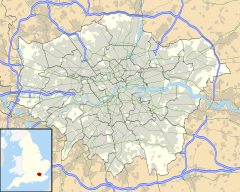The Hale facts for kids
Quick facts for kids The Hale |
|
|---|---|
| Population | 17,437 (2011 Census. Ward) |
| OS grid reference | TQ205918 |
| London borough | |
| Ceremonial county | Greater London |
| Region | |
| Country | England |
| Sovereign state | United Kingdom |
| Post town | LONDON |
| Postcode district | NW7 |
| Post town | EDGWARE |
| Postcode district | HA8 |
| Dialling code | 020 |
| Police | Metropolitan |
| Fire | London |
| Ambulance | London |
| EU Parliament | London |
| UK Parliament |
|
| London Assembly |
|
The Hale is a lively area and local ward located in the London Borough of Barnet. It sits right where the eastern part of Edgware meets the western part of Mill Hill. The heart of The Hale is a small shopping area. This spot is at the meeting point of Deans Lane, Hale Lane, and Selvage Lane.
This central area is also known as Upper Hale. However, many local people call it the 'Green Man'. This name comes from a famous old pub that stood there for a very long time. It was there since at least the early 1700s!
There's also a smaller part of The Hale called Lower Hale. This area is around the junction of Hale Lane, Farm Road, and a bridge over Deans Brook. Most people think of Lower Hale as part of Edgware. The traditional area of The Hale stretches north to the A41 road and Apex Corner. Its southern edge is marked by an old, unused railway line. This line is just south of West Way and Hale Drive. Beyond it lies Burnt Oak. Today, the official borough ward boundaries are a bit larger.
Contents
The Hale's Past: How it Grew
The Hale was mostly countryside until the 1900s. There were only a few buildings, like the Green Man pub and the Railway Tavern. The Railway Tavern is still there today. There were also farms in Upper Hale and Lower Hale. The Green Man pub became quite famous in the 1800s. People even came to watch sports like boxing there.
The pub was completely rebuilt in the late 1920s. Later, in the late 1980s, it became a Tex-Mex restaurant called Everglades. Now, it's a Harvester Inn known as the Jolly Badger.
From Countryside to Community
At the start of the 1900s, The Hale was a popular spot for day trips. People from Central London would visit the two pubs. But the area changed very quickly in the late 1920s and early 1930s. This rapid growth happened because the Northern line underground train reached Edgware station in 1924.
After the train arrived, new bus services started. These buses connected Edgware station to The Hale and Mill Hill. The farms in Upper Hale and Lower Hale were sold. New homes were built on the land. For example, the Hale Estate was built in the late 1920s. This estate is around the east side of Selvage Lane, Sunbury Avenue, Sunbury Gardens, and Maxwelton Avenue. Since the early 1930s, The Hale has been a suburban area. It mainly has private detached and semi-detached houses.
Important Buildings in The Hale
One special building in The Hale is a church named after John Keble. It's a Grade II-listed building. This means it's an important historical building. It has a modern style and was finished in 1936.
Another important building is Maxwelton House. During recent renovations, people discovered it's one of the oldest buildings in the wider Edgware and Mill Hill areas. It is now a school building on Hale Lane. In 1932, a place called the John Grooms Crippleage opened. It was just south of the A41 Edgware Way. This center closed in the 1980s. Modern private homes now stand where it used to be.
Where is The Hale?
 |
Edgware | Scratchwood | Moat Mount |  |
| Deans Brook | Mill Hill | |||
| Burnt Oak | Grahame Park | Colindale |
The Hale is surrounded by several other areas. To its northwest is Edgware. To the north, you'll find Scratchwood. Moat Mount is to the northeast. The Deans Brook runs to the west. Mill Hill is to the east. To the southwest is Burnt Oak. Grahame Park is to the south, and Colindale is to the southeast.
Getting Around The Hale
The Hale once had its own train station. It was called Mill Hill (The Hale) railway station and was on Bunns Lane. It opened in 1906 but closed in 1939. Today, the closest train station is Mill Hill Broadway railway station. It's just a short walk away.
Bus Services
Many London Buses routes serve The Hale directly. These include routes 221, 240, 292, and 303. Other routes, like 113, 186, and Uno route 614, serve the A41 road at the north end of the area. All these bus routes also go to Edgware station. This station is on the Northern line and is a main way to travel to and from The Hale.
In the past, the 'Green Man' pub area in Mill Hill was a starting or ending point for buses. A famous example was the 52 bus from Victoria. This route ran from the early 1930s. It changed in 1967 when the M1 motorway was built. The bus route was then moved to the new bus station at Mill Hill Broadway. The 52 route was eventually replaced in 1992 by today's 302 bus.


